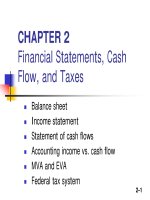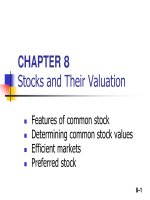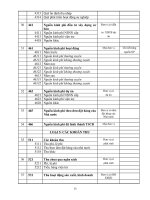International Financial Management phần 2 potx
Bạn đang xem bản rút gọn của tài liệu. Xem và tải ngay bản đầy đủ của tài liệu tại đây (460.54 KB, 10 trang )
Foreign Exchange Quotations, 58
Interpreting Foreign Exchange Quotations, 61
Forward, Futures, and Options Markets, 64
International Money Market, 65
Origins and Development, 66
Money Market Interest Rates among Currencies, 67
Standardizing Global Bank Regulations, 68
International Credit Market, 69
Syndicated Loans, 69
Impact of the Credit Crisis on the Credit Market, 70
International Bond Market, 70
Eurobond Market, 70
Development of Other Bond Markets, 72
International Stock Markets, 72
Issuance of Stock in Foreign Markets, 72
Issuance of Foreign Stock in the United States, 73
Listing of Non-U.S. Firms on U.S. Stock Exchanges, 75
Governance: Effect of Sarbanes-Oxley Act on Foreign Stock Listings, 75
Investing in Foreign Stock Markets, 75
Governance: How Stock Market Characteristics Vary among Countries, 76
How Financial Markets Serve MNCs, 78
Summary, 79
Point Counter-Point: Should Firms That Go Public Engage in International Listings? 79
Self-Test, 80
Questions and Applications, 80
Advanced Questions, 81
Discussion in the Boardroom, 82
Running Your Own MNC, 82
Blades, Inc. Case: Decisions to Use International Financial Markets, 82
Small Business Dilemma: Use of the Foreign Exchange Markets by the Sports Exports
Company, 83
Internet/Excel Exercises, 83
References, 84
Appendix 3: Investing in International Financial Markets is made available to you at www.
cengage.com/finance/madura.
4: EXCHANGE RATE DETERMINATION 95
Measuring Exchange Rate Movements, 95
Exchange Rate Equilibrium, 96
Demand for a Currency, 97
Supply of a Currency for Sale, 97
Equilibrium, 98
Factors That Influence Exchange Rates, 99
Relative Inflation Rates, 100
Relative Interest Rates, 101
Relative Income Levels, 102
Government Controls, 102
Expectations, 103
Interaction of Factors, 104
Influence of Factors across Multiple Currency Markets, 105
Contents ix
Copyright 2010 Cengage Learning. All Rights Reserved. May not be copied, scanned, or duplicated, in whole or in part. Due to electronic rights, some third party content may be suppressed from the eBook and/or eChapter(s).
Editorial review has deemed that any suppressed content does not materially affect the overall learning experience. Cengage Learning reserves the right to remove additional content at any time if subsequent rights restrictions require it.
Licensed to:
iChapters User
Movements in Cross Exchange Rates, 106
Explaining Movements in Cross Exchange Rates, 107
Anticipation of Exchange Rate Movements, 107
Bank Speculation Based on Expected Appreciation, 107
Bank Speculation Based on Expected Depreciation, 108
Speculation by Individuals, 109
Summary, 110
Point Counter-Point: How Can Persistently Weak Currencies Be Stabilized? 110
Self-Test, 111
Questions and Applications, 111
Advanced Questions, 112
Discussion in the Boardroom, 114
Running Your Own MNC, 114
Blades, Inc. Case: Assessment of Future Exchange Rate Movements, 114
Small Business Dilemma: Assessment by the Sports Exports Company of Factors That Affect
the British Pound’s Value, 115
Internet/Excel Exercises, 116
References, 116
5: CURRENCY DERIVATIVES 117
Forward Market, 117
How MNCs Use Forward Contracts, 117
Non-Deliverable Forward Contracts, 120
Currency Futures Market, 121
Contract Specifications, 122
Trading Currency Futures, 123
Trading Platforms for Currency Futures, 123
Comparison to Forward Contracts, 123
Pricing Currency Futures, 124
Credit Risk of Currency Futures Contracts, 125
How Firms Use Currency Futures, 125
Closing Out a Futures Position, 125
Speculation with Currency Futures, 126
Currency Options Market, 127
Option Exchanges, 127
Over-the-Counter Market, 128
Currency Call Options, 128
Factors Affecting Currency Call Option Premiums, 129
How Firms Use Currency Call Options, 129
Speculating with Currency Call Options, 130
Currency Put Options, 133
Factors Affecting Currency Put Option Premiums, 133
Hedging with Currency Put Options, 134
Speculating with Currency Put Options, 134
Contingency Graphs for Currency Options, 136
Contingency Graph for a Purchaser of a Call Option, 136
Contingency Graph for a Seller of a Call Option, 136
Contingency Graph for a Purchaser of a Put Option, 136
Contingency Graph for a Seller of a Put Option, 137
Conditional Currency Options, 138
European Currency Options, 139
x Contents
Copyright 2010 Cengage Learning. All Rights Reserved. May not be copied, scanned, or duplicated, in whole or in part. Due to electronic rights, some third party content may be suppressed from the eBook and/or eChapter(s).
Editorial review has deemed that any suppressed content does not materially affect the overall learning experience. Cengage Learning reserves the right to remove additional content at any time if subsequent rights restrictions require it.
Licensed to:
iChapters User
Summary, 140
Point Counter-Point: Should Speculators Use Currency Futures or Options? 140
Self-Test, 140
Questions and Applications, 141
Advanced Questions, 144
Discussion in the Boardroom, 147
Running Your Own MNC, 147
Blades, Inc. Case: Use of Currency Derivative Instruments, 147
Small Business Dilemma: Use of Currency Futures and Options by the Sports Exports
Company, 148
Internet/Excel Exercises, 149
References, 149
Appendix 5A: Currency Option Pricing is made available to you at www.cengage.com/
finance/madura.
Appendix 5B: Currency Option Combinations is made available to you at www.cengage.
com/finance/madura.
Part 1 Integrative Problem: The International Financial Environment is made available to
you at www.cengage.com/finance/madura.
PART 2: Exchange Rate Behavior 169
6: GOVERNMENT INFLUENCE ON EXCHANGE RATES 171
Exchange Rate Systems, 171
Fixed Exchange Rate System, 171
Freely Floating Exchange Rate System, 173
Managed Float Exchange Rate System, 174
Pegged Exchange Rate System, 175
Dollarization, 178
Classification of Exchange Rate Arrangements, 179
A Single European Currency, 180
Impact on European Monetary Policy, 180
Impact on the Valuation of Businesses in Europe, 180
Impact on Financial Flows, 181
Impact on Exchange Rate Risk, 181
Status Report on the Euro, 181
Government Intervention, 182
Reasons for Government Intervention, 182
Direct Intervention, 183
Indirect Intervention, 185
Intervention as a Policy Tool, 186
Influence of a Weak Home Currency, 186
Influence of a Strong Home Currency, 186
Summary, 188
Point Counter-Point: Should China Be Forced to Alter the Value of Its Currency? 188
Self-Test, 189
Questions and Applications, 189
Advanced Questions, 190
Discussion in the Boardroom, 191
Running Your Own MNC, 191
Contents xi
Copyright 2010 Cengage Learning. All Rights Reserved. May not be copied, scanned, or duplicated, in whole or in part. Due to electronic rights, some third party content may be suppressed from the eBook and/or eChapter(s).
Editorial review has deemed that any suppressed content does not materially affect the overall learning experience. Cengage Learning reserves the right to remove additional content at any time if subsequent rights restrictions require it.
Licensed to:
iChapters User
Blades, Inc. Case: Assessment of Government Influence on Exchange Rates, 192
Small Business Dilemma: Assessment of Central Bank Intervention by the Sports Exports
Company, 193
Internet/Excel Exercises, 193
References, 193
Appendix 6: Government Intervention during the Asian Crisis is made available to you at
www.cengage.com/finance/madura.
7: INTERNATIONAL ARBITRAGE AND INTEREST RATE PARITY 203
International Arbitrage, 203
Locational Arbitrage, 203
Triangular Arbitrage, 205
Covered Interest Arbitrage, 208
Comparison of Arbitrage Effects, 212
Interest Rate Parity (IRP), 213
Derivation of Interest Rate Parity, 214
Determining the Forward Premium, 215
Graphic Analysis of Interest Rate Parity, 216
How to Test Whether Interest Rate Parity Exists, 218
Interpretation of Interest Rate Parity, 219
Does Interest Rate Parity Hold? 219
Considerations When Assessing Interest Rate Parity, 219
Forward Premiums across Maturity Markets, 220
Changes in Forward Premiums, 221
Summary, 223
Point Counter-Point: Does Arbitrage Destabilize Foreign Exchange Markets? 224
Self-Test, 224
Questions and Applications, 225
Advanced Questions, 227
Discussion in the Boardroom, 230
Running Your Own MNC, 230
Blades, Inc. Case: Assessment of Potential Arbitrage Opportunities, 230
Small Business Dilemma: Assessment of Prevailing Spot and Forward Rates by the Sports
Exports Company, 231
Internet/Excel Exercise, 231
References, 232
8: RELATIONSHIPS AMONG INFLATION, INTEREST RATES,
AND EXCHANGE RATES 233
Purchasing Power Parity (PPP), 233
Interpretations of Purchasing Power Parity, 233
Rationale behind Relative PPP Theory, 234
Derivation of Purchasing Power Parity, 234
Using PPP to Estimate Exchange Rate Effects, 235
Graphic Analysis of Purchasing Power Parity, 236
Testing the Purchasing Power Parity Theory, 238
Why Purchasing Power Parity Does Not Occur, 241
Purchasing Power Parity in the Long Run, 242
International Fisher Effect (IFE), 243
Implications of the International Fisher Effect, 244
Implications of the IFE for Foreign Investors, 244
xii Contents
Copyright 2010 Cengage Learning. All Rights Reserved. May not be copied, scanned, or duplicated, in whole or in part. Due to electronic rights, some third party content may be suppressed from the eBook and/or eChapter(s).
Editorial review has deemed that any suppressed content does not materially affect the overall learning experience. Cengage Learning reserves the right to remove additional content at any time if subsequent rights restrictions require it.
Licensed to:
iChapters User
Derivation of the International Fisher Effect, 246
Graphic Analysis of the International Fisher Effect, 248
Tests of the International Fisher Effect, 249
Does the International Fisher Effect Hold? 251
Comparison of the IRP, PPP, and IFE, 252
Summary, 253
Point Counter-Point: Does PPP Eliminate Concerns about Long-Term Exchange Rate Risk? 253
Self-Test, 254
Questions and Applications, 254
Advanced Questions, 256
Discussion in the Boardroom, 259
Running Your Own MNC, 259
Blades, Inc. Case: Assessment of Purchasing Power Parity, 259
Small Business Dilemma: Assessment of the IFE by the Sports Exports Company, 260
Internet/Excel Exercises, 260
References, 260
Part 2 Integrative Problem: Exchange Rate Behavior is made available to you at www.
cengage.com/finance/madura.
Midterm Self-Exam, 263
PART 3: Exchange Rate Risk Management 271
9: FORECASTING EXCHANGE RATES 273
Why Firms Forecast Exchange Rates, 273
Forecasting Techniques, 274
Technical Forecasting, 274
Fundamental Forecasting, 276
Market-Based Forecasting, 280
Mixed Forecasting, 283
Reliance on Forecasting Services, 284
Governance of Forecasting Techniques Used, 284
Forecast Error, 284
Measurement of Forecast Error, 284
Forecast Errors among Time Horizons, 285
Forecast Errors over Time Periods, 285
Forecast Errors among Currencies, 286
Forecast Bias, 287
Graphic Evaluation of Forecast Performance, 288
Comparison of Forecasting Methods, 290
Forecasting under Market Efficiency, 291
Using Interval Forecasts, 292
Methods of Forecasting Exchange Rate Volatility, 293
Summary, 294
Point Counter-Point: Which Exchange Rate Forecast Technique Should MNCs Use? 294
Self-Test, 294
Questions and Applications, 295
Advanced Questions, 296
Discussion in the Boardroom, 299
Running Your Own MNC, 299
Contents xiii
Copyright 2010 Cengage Learning. All Rights Reserved. May not be copied, scanned, or duplicated, in whole or in part. Due to electronic rights, some third party content may be suppressed from the eBook and/or eChapter(s).
Editorial review has deemed that any suppressed content does not materially affect the overall learning experience. Cengage Learning reserves the right to remove additional content at any time if subsequent rights restrictions require it.
Licensed to:
iChapters User
Blades, Inc. Case: Forecasting Exchange Rates, 299
Small Business Dilemma: Exchange Rate Forecasting by the Sports Exports
Company, 300
Internet/Excel Exercises, 301
References, 301
10: MEASURING EXPOSURE TO EXCHANGE RATE FLUCTUATIONS 303
Relevance of Exchange Rate Risk, 303
The Investor Hedge Argument, 303
Currency Diversification Argument, 304
Stakeholder Diversification Argument, 304
Response from MNCs, 304
Transaction Exposure, 305
Estimating “Net” Cash Flows in Each Currency, 305
Exposure of an MNC’s Portfolio, 307
Transaction Exposure Based on Value at Risk, 309
Economic Exposure, 313
Exposure to Local Currency Appreciation, 314
Exposure to Local Currency Depreciation, 315
Economic Exposure of Domestic Firms, 315
Measuring Economic Exposure, 316
Translation Exposure, 318
Does Translation Exposure Matter? 318
Determinants of Translation Exposure, 319
Examples of Translation Exposure, 320
Summary, 320
Point Counter-Point: Should Investors Care about an MNC’s Translation Exposure? 321
Self-Test, 321
Questions and Applications, 322
Advanced Questions, 323
Discussion in the Boardroom, 328
Running Your Own MNC, 328
Blades, Inc. Case: Assessment of Exchange Rate Exposure, 328
Small Business Dilemma: Assessment of Exchange Rate Exposure by the Sports Exports C ompany, 330
Internet/Excel Exercises, 330
References, 331
11: MANAGING TRANSACTION EXPOSURE 333
Hedging Exposure to Payables, 333
Forward or Futures Hedge on Payables, 333
Money Market Hedge on Payables, 334
Call Option Hedge on Payables, 335
Summary of Techniques to Hedge Payables, 337
Optimal Technique for Hedging Payables, 337
Optimal Hedge versus No Hedge on Payables, 338
Evaluating the Hedge Decision, 340
Hedging Exposure to Receivables, 340
Forward or Futures Hedge on Receivables, 341
Money Market Hedge on Receivables, 341
Put Option Hedge on Receivables, 341
Optimal Technique for Hedging Receivables, 344
Optimal Hedge versus No Hedge, 345
xiv Contents
Copyright 2010 Cengage Learning. All Rights Reserved. May not be copied, scanned, or duplicated, in whole or in part. Due to electronic rights, some third party content may be suppressed from the eBook and/or eChapter(s).
Editorial review has deemed that any suppressed content does not materially affect the overall learning experience. Cengage Learning reserves the right to remove additional content at any time if subsequent rights restrictions require it.
Licensed to:
iChapters User
Evaluating the Hedge Decision, 347
Comparison of Hedging Techniques, 348
Hedging Policies of MNCs, 348
Selective Hedging, 348
Limitations of Hedging, 349
Limitation of Hedging an Uncertain Amount, 349
Limitation of Repeated Short-Term Hedging, 350
Hedging Long-Term Transaction Exposure, 352
Long-Term Forward Contract, 352
Parallel Loan, 352
Alternative Hedging Techniques, 352
Leading and Lagging, 353
Cross-Hedging, 353
Currency Diversification, 353
Summary, 354
Point Counter-Point: Should an MNC Risk Overhedging? 354
Self-Test, 355
Questions and Applications, 355
Advanced Questions, 358
Discussion in the Boardroom, 363
Running Your Own MNC, 363
Blades, Inc. Case: Management of Transaction Exposure, 363
Small Business Dilemma: Hedging Decisions by the Sports Exports Company, 365
Internet/Excel Exercises, 365
References, 366
Appendix 11: Nontraditional Hedging Techniques is made available to you at www.cengage.
com/finance/madura.
12: MANAGING ECONOMIC EXPOSURE AND TRANSLATION
EXPOSURE 373
Managing Economic Exposure, 373
Assessing Economic Exposure, 374
Restructuring to Reduce Economic Exposure, 375
Issues Involved in the Restructuring Decision, 378
A Case Study on Hedging Economic Exposure, 379
Savor Co.’s Dilemma, 379
Assessment of Economic Exposure, 380
Assessment of Each Unit’s Exposure, 380
Identifying the Source of the Unit’s Exposure, 381
Possible Strategies to Hedge Economic Exposure, 381
Savor’s Hedging Solution, 383
Limitations of Savor’s Optimal Hedging Strategy, 383
Hedging Exposure to Fixed Assets, 383
Managing Translation Exposure, 384
Hedging with Forward Contracts, 385
Limitations of Hedging Translation Exposure, 385
Governance: Governing the Hedge of Translation Exposure, 386
Summary, 386
Point Counter-Point: Can an MNC Reduce the Impact of Translation
Exposure by Communicating? 387
Contents xv
Copyright 2010 Cengage Learning. All Rights Reserved. May not be copied, scanned, or duplicated, in whole or in part. Due to electronic rights, some third party content may be suppressed from the eBook and/or eChapter(s).
Editorial review has deemed that any suppressed content does not materially affect the overall learning experience. Cengage Learning reserves the right to remove additional content at any time if subsequent rights restrictions require it.
Licensed to:
iChapters User
Self-Test, 387
Questions and Applications, 388
Advanced Questions, 388
Discussion in the Boardroom, 390
Running Your Own MNC, 390
Blades, Inc. Case: Assessment of Economic Exposure, 390
Small Business Dilemma: Hedging the Sports Exports Company’s Economic Exposure
to Exchange Rate Risk, 391
Internet/Excel Exercises, 392
References, 392
Part 3 Integrative Problem: Exchange Rate Risk Management is made available to you at
www.cengage.com/finance/madura.
PART 4: Long-Term Asset and Liability Management 395
13: DIRECT FOREIGN INVESTMENT 397
Motives for Direct Foreign Investment, 397
Revenue-Related Motives, 397
Cost-Related Motives, 398
Governance: Selfish Managerial Motives for DFI, 400
Comparing Benefits of DFI among Countries, 400
Comparing Benefits of DFI over Time, 401
Benefits of International Diversification, 402
Diversification Analysis of International Projects, 404
Diversification among Countries, 406
Host Government Views of DFI, 407
Incentives to Encourage DFI, 407
Barriers to DFI, 407
Government-Imposed Conditions to Engage in DFI, 408
Summary, 409
Point Counter-Point: Should MNCs Avoid DFI in Countries with Liberal
Child Labor Laws? 409
Self-Test, 409
Questions and Applications, 410
Advanced Questions, 411
Discussion in the Boardroom, 411
Running Your Own MNC, 411
Blades, Inc. Case: Consideration of Direct Foreign Investment, 412
Small Business Dilemma: Direct Foreign Investment Decision by the
Sports Exports Company, 413
Internet/Excel Exercises, 413
References, 414
14: MULTINATIONAL CAPITAL BUDGETING 415
Subsidiary versus Parent Perspective, 415
Tax Differentials, 415
Restricted Remittances, 415
Excessive Remittances, 416
Exchange Rate Movements, 416
Summary of Factors, 416
xvi Contents
Copyright 2010 Cengage Learning. All Rights Reserved. May not be copied, scanned, or duplicated, in whole or in part. Due to electronic rights, some third party content may be suppressed from the eBook and/or eChapter(s).
Editorial review has deemed that any suppressed content does not materially affect the overall learning experience. Cengage Learning reserves the right to remove additional content at any time if subsequent rights restrictions require it.
Licensed to:
iChapters User
Input for Multinational Capital Budgeting, 417
Multinational Capital Budgeting Example, 419
Background, 419
Analysis, 420
Other Factors to Consider, 422
Exchange Rate Fluctuations, 423
Inflation, 425
Financing Arrangement, 425
Blocked Funds, 428
Uncertain Salvage Value, 429
Impact of Project on Prevailing Cash Flows, 430
Host Government Incentives, 430
Real Options, 431
Adjusting Project Assessment for Risk, 431
Risk-Adjusted Discount Rate, 431
Sensitivity Analysis, 432
Governance: Managerial Controls over the Use of Sensitivity Analysis, 432
Simulation, 432
Summary, 433
Point Counter-Point: Should MNCs Use Forward Rates to Estimate Dollar
Cash Flows of Foreign Projects? 434
Self-Test, 434
Questions and Applications, 434
Advanced Questions, 437
Discussion in the Boardroom, 440
Running Your Own MNC, 440
Blades, Inc. Case: Decision by Blades, Inc., to Invest in Thailand, 440
Small Business Dilemma: Multinational Capital Budgeting by the
Sports Exports Company, 442
Internet/Excel Exercises, 442
References, 442
Appendix 14: Incorporating International Tax Law in Multinational
Capital Budgeting is made available to you at www.cengage.com/finance/madura.
15: INTERNATIONAL CORPORATE GOVERNANCE AND CONTROL 451
International Corporate Governance, 451
Governance by Board Members, 451
Governance by Institutional Investors, 452
Governance by Shareholder Activists, 452
International Corporate Control, 452
Motives for International Acquisitions, 453
Trends in International Acquisitions, 453
Barriers to International Corporate Control, 454
Model for Valuing a Foreign Target, 454
Factors Affecting Target Valuation, 456
Target-Specific Factors, 456
Country-Specific Factors, 457
Example of the Valuation Process, 458
International Screening Process, 458
Estimating the Target’s Value, 459
Changes in Valuation over Time, 461
Contents xvii
Copyright 2010 Cengage Learning. All Rights Reserved. May not be copied, scanned, or duplicated, in whole or in part. Due to electronic rights, some third party content may be suppressed from the eBook and/or eChapter(s).
Editorial review has deemed that any suppressed content does not materially affect the overall learning experience. Cengage Learning reserves the right to remove additional content at any time if subsequent rights restrictions require it.
Licensed to:
iChapters User
Disparity in Foreign Target Valuations, 462
Estimated Cash Flows of the Foreign Target, 462
Exchange Rate Effects on the Funds Remitted, 463
Required Return of Acquirer, 463
Other Corporate Control Decisions, 463
International Partial Acquisitions, 463
International Acquisitions of Privatized Businesses, 464
International Divestitures, 464
Control Decisions as Real Options, 465
Call Option on Real Assets, 466
Put Option on Real Assets, 466
Summary, 467
Point Counter-Point: Can a Foreign Target Be Assessed Like Any Other Asset? 467
Self-Test, 468
Questions and Applications, 468
Advanced Questions, 469
Discussion in the Boardroom, 472
Running Your Own MNC, 472
Blades, Inc. Case: Assessment of an Acquisition in Thailand, 472
Small Business Dilemma: Multinational Restructuring by the Sports
Exports Company, 474
Internet/Excel Exercises, 474
References, 475
16: COUNTRY RISK ANALYSIS 477
Why Country Risk Analysis Is Important, 477
Country Risk Factors, 478
Political Risk, 478
Financial Risk, 480
Assessment of Risk Factors, 481
Techniques to Assess Country Risk, 482
Checklist Approach, 482
Delphi Technique, 482
Quantitative Analysis, 482
Inspection Visits, 483
Combination of Techniques, 483
Measuring Country Risk, 483
Variation in Methods of Measuring Country Risk, 484
Comparing Risk Ratings among Countries, 485
Actual Country Risk Ratings across Countries, 485
Incorporating Risk in Capital Budgeting, 487
Adjustment of the Discount Rate, 487
Adjustment of the Estimated Cash Flows, 487
Governance: Governance of the Country Risk Assessment, 490
Assessing Risk of Existing Projects, 490
Preventing Host Government Takeovers, 491
Use a Short-Term Horizon, 491
Rely on Unique Supplies or Technology, 491
Hire Local Labor, 491
Borrow Local Funds, 491
xviii Contents
Copyright 2010 Cengage Learning. All Rights Reserved. May not be copied, scanned, or duplicated, in whole or in part. Due to electronic rights, some third party content may be suppressed from the eBook and/or eChapter(s).
Editorial review has deemed that any suppressed content does not materially affect the overall learning experience. Cengage Learning reserves the right to remove additional content at any time if subsequent rights restrictions require it.
Licensed to:
iChapters User









